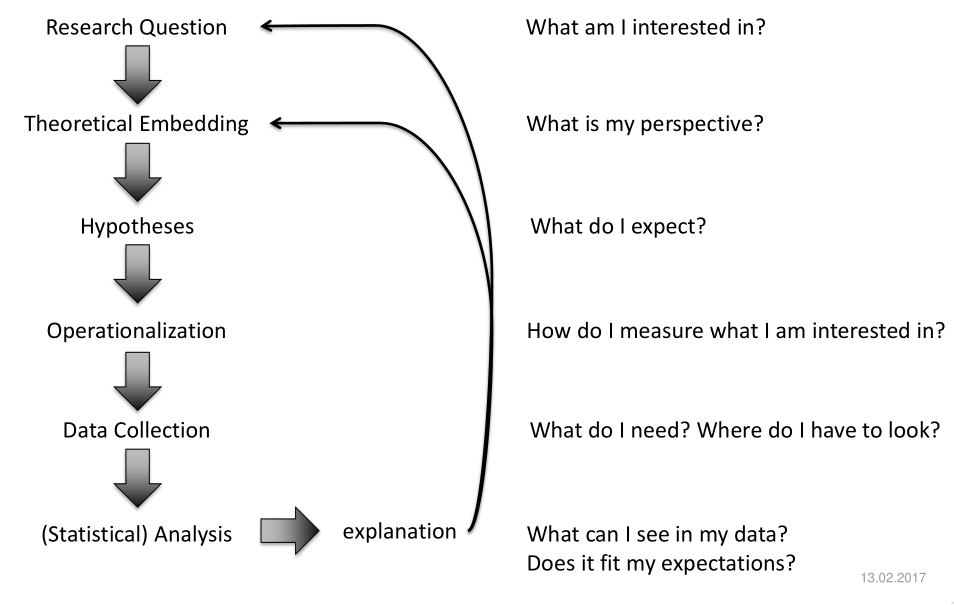2 The scientific process
This week, we talked about the general process of carrying out a study in linguistics (or any other empirical discipline). The flow chart below depicts the scientific process. It does not only capture the steps involved, but also reflects the structure of the majority of academic papers in the field. Even if the sections in a paper aren’t called “operationalization”, etc., the methodological parts usually include a discussion of it.

Step one is always to find a research question, something that is important to the field of research and interesting to the researcher. In general, the more specific, the better. “How do speakers learn phrasal verbs”, is very broad; “how do learners of English learn phrasal verbs,” is still broad; “how are phrasal verbs used in student essays,” is better; “what phrasal verbs are underused in student essays”, is even better. The big questions can only be answered, if at all, by an entire field. An individual study has to be very focused, not only because of the practical requirements of small, time-constrained research groups, but also because of the amount of detail and scrutiny required. The topic above can even be narrowed down more. Most student papers suffer from having a research question that is too broad.
Next, the theoretical part practically requires two important steps. The existing literature has to be reviewed in order to explore, narrow down and define the concepts and the terminology necessary to approach the research question. It is also important to derive expectations that can be formulated as hypotheses. A hypothesis is no longer a vague question, but a very specific statement that can be falsified. Some research is purely exploratory, but most of the time, there are is a clear idea of what we expect to find in the data. Finally, we need to translate the theoretical concepts into measurable concepts. This step is called operationalization, i.e. making it possible to practically operate on an idea. Frequency of occurrence can be understood as theoretical concept describing the amount of times a phenomenon, e.g. a phrasal verb, is experienced by a speaker. In a study, we can only find indicators for this idea, so frequency of occurrence typically (and often implicitly) has an operational definition of frequency of occurrence in a text corpus.
It is important to note that this process is a feedback loop. If at any time, there are good reasons to step back, a researcher should and will go back. Often, if a concept is hard to measure, it is to complex which is a flaw in the conceptual design. Therefore, it might be necessary to go back to the stage of defining the concepts and formulating the hypotheses. If during the data collection new important variables are encountered, that weren’t predicted, it might be necessary to go back and think about how to systematically measure them (operationalize) or go back to the literature to see possible explanations and definitions of the concepts. Even as late as during the statistical analysis, a researcher might realize that they are asking the wrong questions. What is important is that the logic should not be reversed. Most importantly, the hypotheses shouldn’t be picked according to what the data can support. The research question shouldn’t be dictated by the available methods. The explanation derives from the theoretical framework, not vice versa.
Another more abstract model of research is the empirical cycle. It abstracts away the practical part of carrying out a study and is applicable to the general process within a field spanning many studies.

2.1 Tip of the day
Today’s tip is from the category: Things I wish I had learned before my Bachelor Thesis
In short: Tiwilbemba.
Take every .pdf you download and get from your instructors and archive it with a naming scheme you can remember easily. Especially scans from books and collections are an invaluable resource since not everything is digitalized.
My suggestion: lastname_year_keyword: e.g. Deignan_2005_Metaphor.pdf
Also…Get the info for a bibliography entry as soon as you read a text. Platforms like Primo and Google scholar provide bibliography entries in various styles and formats. In a future installment of Tiwilbemba I will discuss the benefits of tools like BibTex, Mendeley, Endnote …
~15s invested per text → hours saved in the long run.